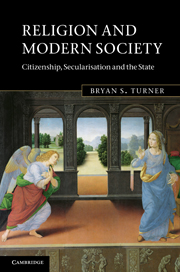Book contents
- Frontmatter
- Contents
- Acknowledgements
- Introduction: the state of the sociology of religion
- Part I Theoretical frameworks: the problem of religion in sociology
- 1 Religion, religions and the body
- 2 Émile Durkheim and the classification of religion
- 3 Max Weber and comparative religion
- 4 Talcott Parsons and the expressive revolution
- 5 Mary Douglas and Modern Primitives
- 6 Pierre Bourdieu and religious practice
- Part II Religion, state and post-secularity
- References
- Index
4 - Talcott Parsons and the expressive revolution
Published online by Cambridge University Press: 05 June 2012
- Frontmatter
- Contents
- Acknowledgements
- Introduction: the state of the sociology of religion
- Part I Theoretical frameworks: the problem of religion in sociology
- 1 Religion, religions and the body
- 2 Émile Durkheim and the classification of religion
- 3 Max Weber and comparative religion
- 4 Talcott Parsons and the expressive revolution
- 5 Mary Douglas and Modern Primitives
- 6 Pierre Bourdieu and religious practice
- Part II Religion, state and post-secularity
- References
- Index
Summary
Introduction: the expressive revolution
Talcott Parsons's sociology of religion remains distinctive in the sense that he did not subscribe to the secularisation thesis, but instead saw American liberal democracy as the fulfilment of Protestant individualism and congregationalism. In addition, his notion of the ‘expressive revolution’ remains an essential tool for the analysis of modern spirituality (Parsons, 1974). The rise of romantic love as a theme of popular culture in modern society can be interpreted as a feature of the expressive revolution, but it is also a legacy of the emphasis on emotional conversion and attachment to the person of Jesus in pietism. The expressive revolution is the modern framework for the legacy of Protestant emotional piety, but at the same time romantic love is an essential component of the contemporary consumer ethic. In this regard, religiosity survives in the context of consumerism as an aspect of what Robert Bellah (1967; Bellah and Tipton, 2006) called ‘civil religion in America’. However, another dimension of this development has been what Alasdair MacIntyre (1984) called ‘emotivism’, that is the breakdown of a shared moral framework in which a moral life could be lived on common grounds. We can regard emotivism as a further extension of the individualism inherent in expressive cultures, in which feeling good is equivalent to being good.
- Type
- Chapter
- Information
- Religion and Modern SocietyCitizenship, Secularisation and the State, pp. 71 - 83Publisher: Cambridge University PressPrint publication year: 2011



